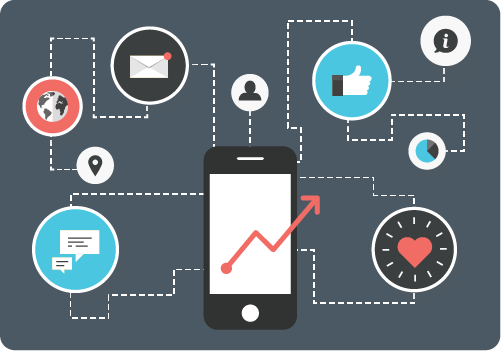Deliver and Improve Your Strategy
Learning Objectives
After completing this unit, you’ll be able to:
- Describe the user life cycle of mobile apps.
- Measure the success of your mobile initiatives.
- Collect feedback and use it to improve.
- Evolve your organization’s mobile strategy.
Adjust Your Course
You’re in the homestretch now. You teamed up with the right travel companion, and you mapped an efficient route that can lead you to your destination. But don’t get too comfortable yet! No adventure is complete without its fair share of dangers, surprises, and detours.
After you craft and execute your mobile strategy, it’s time to optimize it. So in the final phase of your mobile journey, you refine your course and avoid common pitfalls.
Get the Word Out
OK...your steering group came up with your organization’s mobile vision and decided which mobile solution to build. Your project team is delivering it. Now what?
Whether you’re building apps for customers or employees, it’s imperative you get the word out. How can users find out about your app? How can you convince them to try it? This brings us to the next component of mobile strategy: marketing and communication.

Many companies fail to put enough thought and effort into their marketing and communication efforts when launching a mobile app. Of course, your strategy for marketing an internal app to employees will be different than marketing to customers. Here are a few things to think about when planning a mobile launch.
Market Your Customer Apps
Your marketing manager or team will create a marketing plan for the launch of the app. The plan outlines all the activities to perform before, during, and after the release. And once the app is out in the wild, your marketing team also manages future campaigns.
If your organization lacks experience with marketing mobile apps, we recommend reading TUNE Marketing’s ebook, The Complete Guide to Enterprise App Marketing. See the link in the resource section.
Market Your Employee Apps
Make no mistake—launching an internal app requires marketing, too. Typically an internal launch is handled by the same person or team at your organization who’s responsible for change management. Your organization’s communication and training plans should detail your strategy for announcing the app, creating buzz, onboarding users, and keeping them engaged.
For more information about creating effective communication and training plans for a mobile launch, check out the Salesforce Mobile App Rollout module on Trailhead.
The Journey Doesn’t End with Marketing
Your marketing and communication plans are ready to go, and soon users will be beating a path to your door. But the hard work doesn’t end after you convince users to download and install an app. Another big challenge is yet to come: How will you prevent users from abandoning the app?

According to analyst Andrew Chen, the average app loses 77 percent of its users within three days of installing it. After a month, 90 percent of users stop using the app, and by the ninety-day mark, only 5 percent of users continue using a given app.
Wow. Losing 95% of your users in 3 months? As a comedian would say, “Yeesh, tough room.” Whether you’re building apps for your customers, partners, or employees, recognize that you’re competing for two very scarce commodities—the time and attention of mobile users.
So how do you keep your big mobile project from ending up in the app graveyard?
Drive Adoption and Engagement
To capture the continued interest and attention of your mobile audience, you need to develop a plan for engaging users and driving adoption. That brings us to the final component of mobile strategy: adoption and engagement.

When it comes to apps, it’s wise to heed the old adage: You never get a second chance to make a first impression. From the moment users first launch your mobile app, you have to start building and nurturing your relationship with them. If you can demonstrate the value of the app and encourage users to return, you’ll have a shot at winning their attention, and hopefully their hearts, too.
Of course, your engagement strategy will differ depending on which stage of the life cycle your users are in. Here are the four phases of the typical app life cycle.
Phase |
Questions to Address |
|---|---|
Acquisition |
How will people discover your app? How will you convince them to try it? |
Onboarding |
How will you make it easy for people to register and activate your app? How will you expose new users to popular features? Can you encourage follow-up actions to drive users back to your app? |
Growth |
How will you improve your app’s ratings and reviews? Can you get your users to make referrals? If your app generates revenue, how will you drive conversions? |
Retention |
How will you identify users who are at risk for drop-off? How will you reengage those users? Can you personalize the reengagement prompts so they’re enticing and not annoying? How will you build loyalty? How will you handle complaints and feedback? |
Every app is different, so we can’t give you specific details about how to drive adoption and engagement. If you’d like some ideas to get the creative juices flowing, be sure to read Localytics’ guide App User Lifecycle: The Four Stages of Ensuring Happy Users. It’s linked in the resources section.
Measure Success
You’ve probably heard the saying that the journey is the destination. And maybe that touchy-feely stuff is true, but your organization is probably looking for something a little more concrete. You know...like results.
Using analytics to monitor the effectiveness of your mobile initiatives is critical. The data provides insights that will:
- Prove mobile ROI and help build support for future mobile projects.
- Allow your steering group to evolve your overall mobile strategy.
- Inform and guide the efforts of your development and marketing teams.

Let’s go over the two main types of analytics that can help your organization measure success.
Business Metrics
When defining the business objectives for your mobile strategy, your steering committee established KPIs and metrics to help measure the results of your mobile initiative. And now that your company has launched its mobile app, you can evaluate the data and review the results:
- What were your baseline measurements before launch?
- What were your target metrics?
- How did you stack up against your goals?
- If you fell short of your numbers, are there ways to improve the results? (For example, maybe the app is missing a feature necessary for higher adoption, or perhaps your marketing team needs to launch an onboarding campaign to drive daily usage.)
- Does your overall mobile strategy need to be adjusted after reviewing the data?
Engagement Metrics
In addition to analyzing KPIs and business metrics, your organization also needs to monitor user engagement. Here’s some of the user data your organization should track:
- The number of daily active users (DAU)
- The number of monthly active users (MAU)
- Retention rates (daily, weekly, monthly, and quarterly)
- Which features are the most and least popular
- Where in their life cycle users tend to drop off and stop using the app
Gather Feedback
Metrics are great, but there’s another important way to evaluate the performance of your app—by listening directly to your customers (or employees, as the case may be). Don’t forget to reach out to users to find out more about their likes and dislikes, their struggles and successes. You can learn details that don’t surface when measuring analytics alone.

There are a lot of methods for collecting user feedback, but some of the most common are:
- Surveys, polls, and focus groups
- Interviews and usability testing
- Online user forums and communities
- Social media (or for internal apps, your enterprise collaboration tool)
- In-app feedback forms
- User ratings and comments in App Store and Google Play
Iterate, Iterate, Iterate
We’ve been referring to your mobile initiatives as “projects” in this module, but let’s clear something up. Apps aren’t projects—they’re products.
Products have to change to meet the needs of users. If you think you can release a mobile app and call it a day, you’ll be in for a rude awakening when the app ultimately fails. That’s why it’s helpful to take an agile approach when developing mobile apps.

With agile development, your organization continuously evaluates analytics and user feedback, then uses those insights to manage the future of the app. Which features should be added? Which features should be improved and how?
And because agile emphasizes frequent releases with short development cycles, you get immediate feedback about what’s working and what isn’t. Then your organization can feel confident it’s creating a product users will love.
Evolve Your Mobile Strategy
Well, it’s been quite an adventure. When you started this mobile journey, your organization’s portfolio of mobile apps was just a twinkle in your eye, and now you have the knowledge and tools required to make it a reality. A comprehensive mobile strategy is the key to your organization’s mobile transformation.
But here’s the funny thing about a mobile journey...it actually never ends. A truly successful mobile strategy is one that evolves and grows.
After your company launches its first mobile app, it’s time to reflect and make course corrections. What lessons did you learn? What will you do differently next time? And speaking of next time, be sure to revisit your list of potential app ideas to decide which one to tackle next. But remember, your users’ needs and your organization’s objectives are constantly changing. It’s a good idea to review and refine your overall mobile strategy every 6 to 12 months.
So to recap: craft your strategy, execute it, and then optimize it. Then repeat. Let’s call it the Virtuous Circle of Mobility—your mobile journey is a recurring cycle of events, and the results of each one increases the beneficial results of the next. And now that your organization has begun its path to mobile transformation, the sky’s the limit.
To mobility…and beyond!

Resources